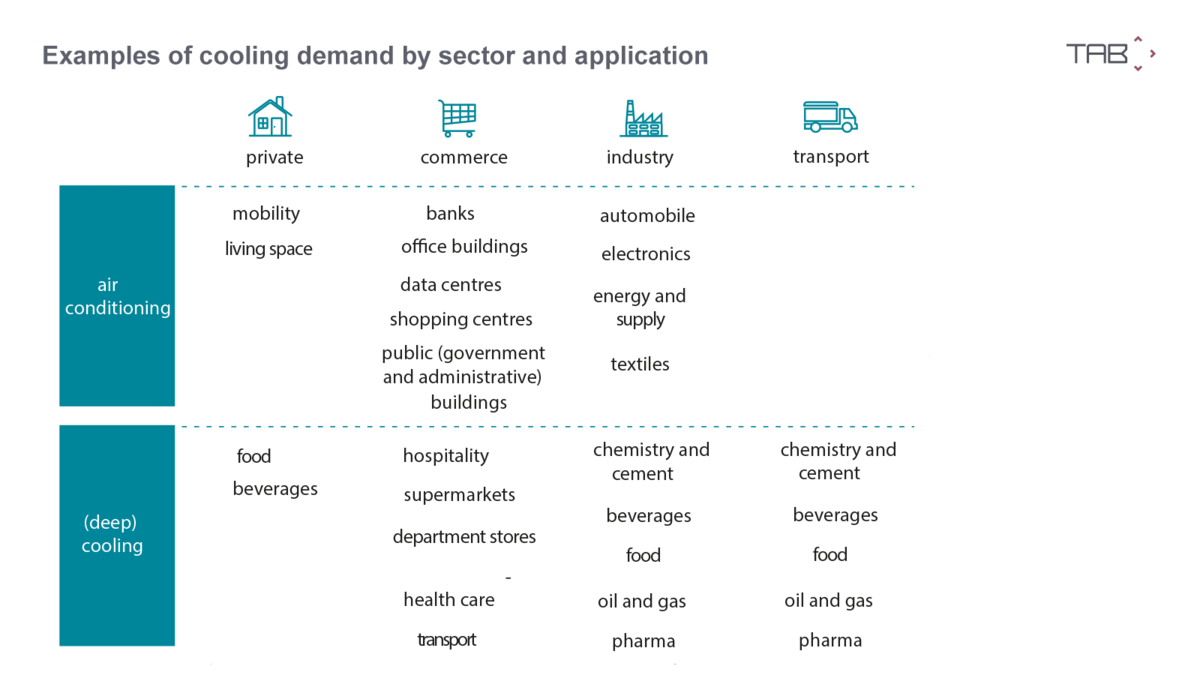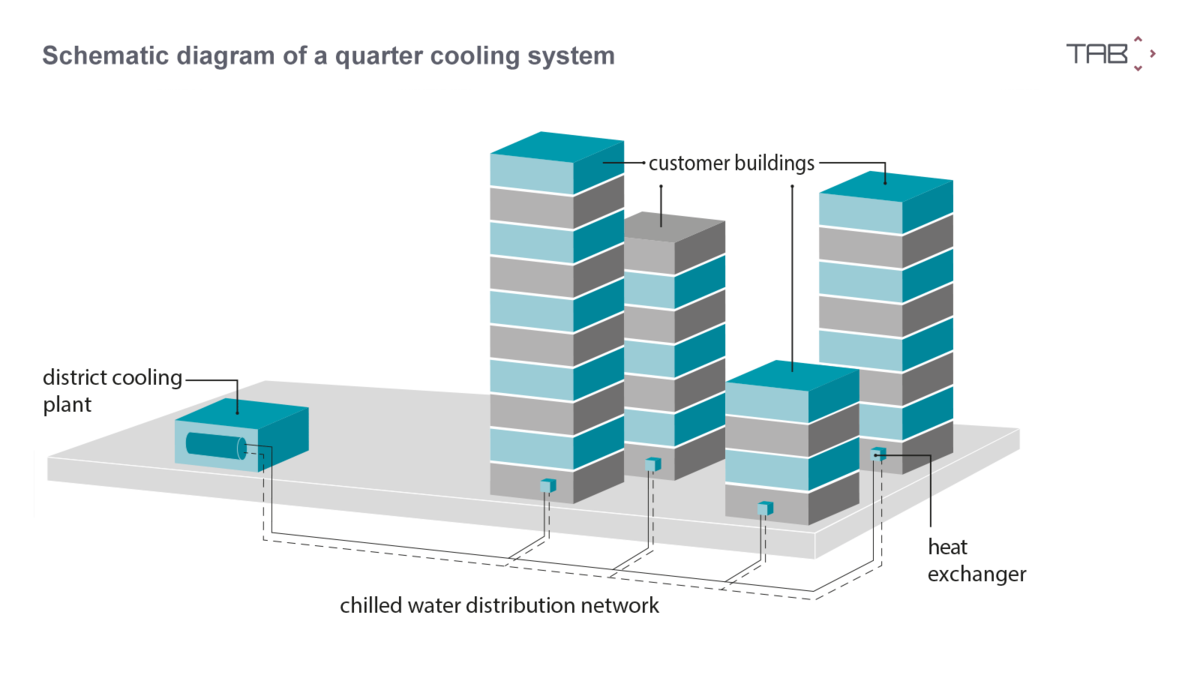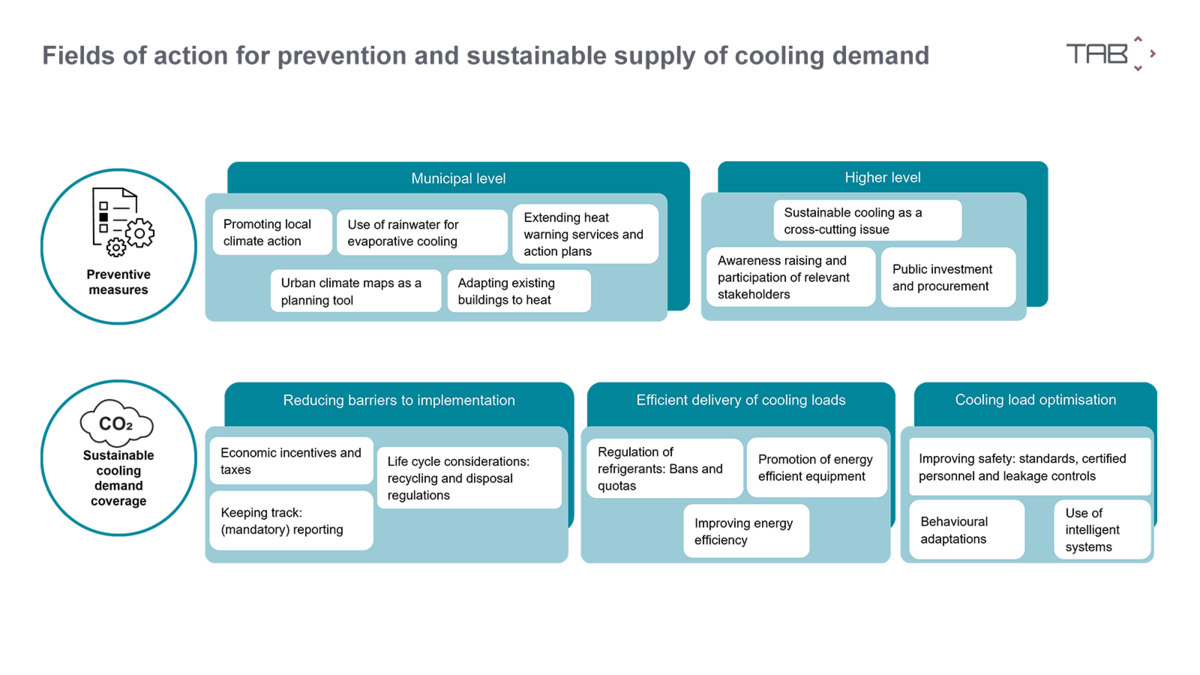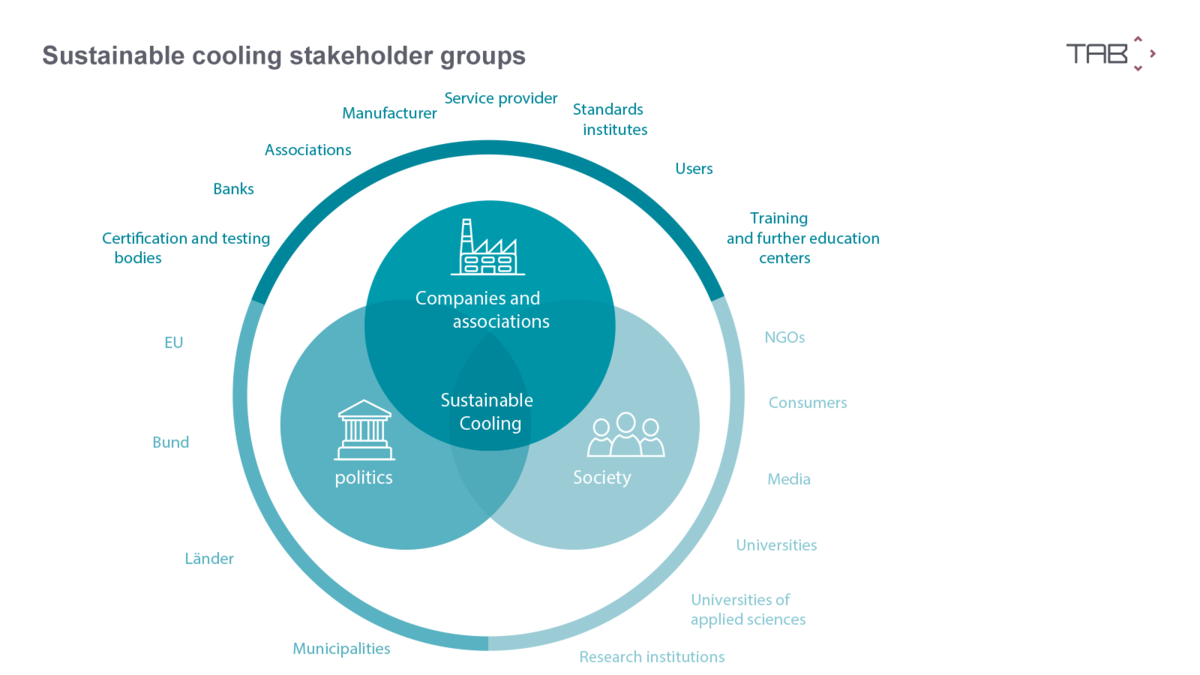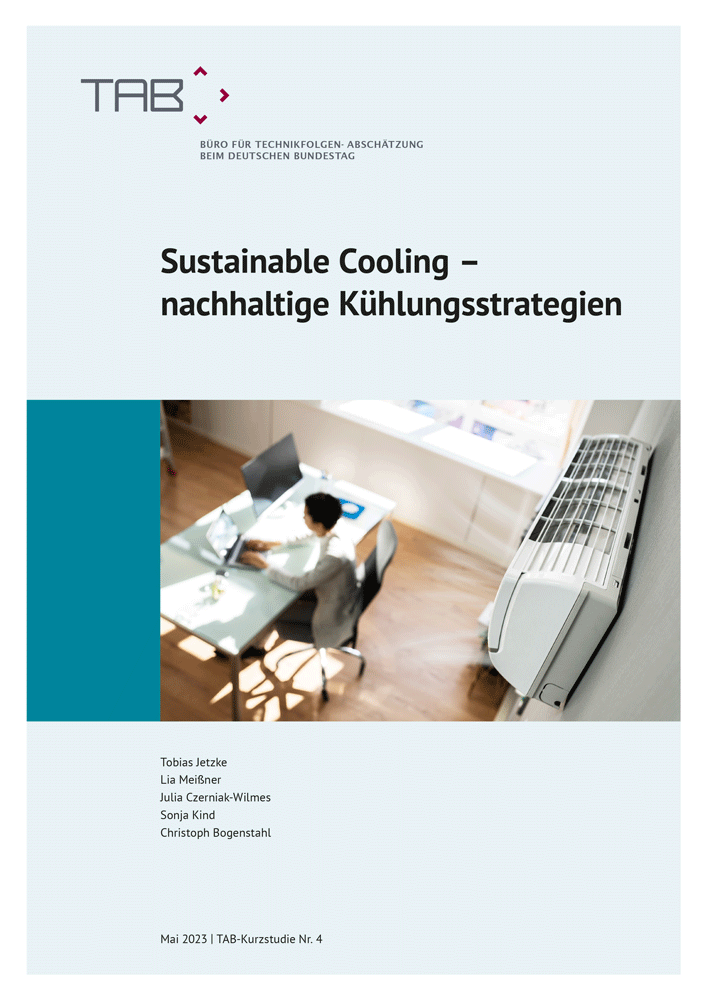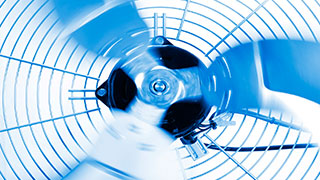
Sustainable Cooling
- Project team:
Tobias Jetzke (Project Manager), Lia Meißner, Julia Czerniak-Wilmes, Christoph Bogenstahl, Sonja Kind
- Thematic area:
- Topic initiative:
Committee on Education, Research and Technology Assessment
- Analytical approach:
TA brief study
- Startdate:
2021
- Enddate:
2023

The growing demand for cooling and air conditioning must be met in a sustainable way to break the spiral of negative interactions. Rising temperatures increase the demand for cooling and air conditioning. If these systems are inefficient, use climate-damaging refrigerants or are powered by fossil fuels, they contribute to climate change. What areas of innovation have the potential to make cooling sustainable? What policy options can be used to drive the implementation of cooling strategies?
At a glance
sprungmarken_marker_3848
Climate change increases the need for cooling, but inefficient cooling equipment adds to emissions and climate change.
Other drivers include population growth in countries with the hottest and sometimes wettest climates and increasing urbanisation. With evaporative cooling hampered by urbanisation, urban temperatures rise due to the heat island effect.
Overheating or inadequate access to cooling has multiple and diverse impacts. As ambient temperatures become more intolerable for people, physical and mental health is affected, which can have economic consequences, for example on the productivity of outdoor workers. There are also indirect impacts on people, such as reduced agricultural yields or damage to transport infrastructure and energy supplies. There are also environmental impacts, such as on air and water quality, and social impacts, such as on safety or social equity.
There is a risk that the effects of overheating and the increasing need for cooling will create a vicious circle: cooling exacerbates global warming because the necessary electricity is still largely generated from fossil fuels, causing additional CO2 emissions. In addition, refrigeration and air conditioning systems leak refrigerants. At the same time, worsening global warming will in turn lead to increased demand for cooling.
Efficiency improvements, the use of natural refrigerants, refrigerant recycling and the development of new sustainable technologies are important technical innovations.
Technological solutions can be used to reduce temperatures in refrigeration circuits by adding mechanical energy or heat. In particular, more intensive use of cooling technologies that are already available but little known or used can contribute to reducing the electricity consumption of future cooling solutions. For example, active or passive cooling using heat pumps offers energy saving potential. Active cooling uses the reverse process of adding heat to rooms by absorbing the ambient temperature. Passive heat pump cooling, on the other hand, combines this technology with a surface heating system and transfers excess room heat to water or brine.
Natural refrigerants such as propane and isobutane can be used for domestic air conditioning and refrigeration. The recycling of refrigerants already on the market is becoming increasingly interesting from an economic point of view. As part of a circular economy, refrigerants can be reprocessed so that they regain their original properties and can be used in the same way as new refrigerants.
The most important thing, however, is to avoid the need for cooling in the first place and to use passive solutions to ensure that room temperatures do not rise too much.
Sustainable cooling can be achieved not only through technical innovations, but also through behavioural changes and urban planning measures.
Sustainable cooling aims to provide adequate thermal comfort for people in their environment and therefore refers to approaches that prevent the need for cooling in the first place as well as processes where the reduction of cooling demand, air conditioning and (deep) cooling have no or low environmental impact and are at the same time financially affordable and equally accessible to different social strata, i.e. inclusive.
Sustainable cooling appears to be indispensable for achieving the goals of the Paris Climate Agreement. While active cooling methods require the addition of engineering work or thermal energy for cooling or air conditioning, passive cooling methods do not require the addition of energy or a refrigerant circuit.
Cooling needs can arise wherever people interact with their environment and depend on thermal comfort. They can essentially be distinguished according to the intended use of air conditioning and (deep) cooling. Depending on the intended use, whether in private households or in different economic sectors (e.g. meat or bakery industry, supermarkets, hotel and catering industry, food and chemical industry), different cooling technologies exist.
Cities, especially those with high population densities, can increasingly become heat islands. Urban cooling solutions can reduce both indoor and outdoor temperatures in cities by reducing heat input. As cities differ in terms of geography, size and layout, building types and construction methods, as well as climatic and meteorological conditions, individually adapted strategies are needed to deal with increasing heat, combining the various available solutions adapted to local conditions.
Neighbourhood or district cooling networks can also play an important role. Possible solutions include cool roofs, pavements and walls through greening, lighting and material selection. The development of green infrastructure and urban planning measures to maximise natural wind flow and create water areas also contribute to cooling, as does the implementation of neighbourhood cooling systems (see figure) and public cooling centres. Finally, structural measures to cool indoor spaces also contribute to people's thermal comfort.
New business models and processes, together with social innovations, help to implement sustainable cooling strategies.
Social innovations include new approaches to social change and policy innovations, as well as new individual lifestyles or ways of living together in response to social or climate challenges. One example is the siesta.
Business model innovations, such as cooling as a service models, are characterised by the fact that they change the way in which value is created for customers (novel customer benefits), how it is created and how it can generate revenue for the company.
Process innovations can relate to the improvement of processes within a company or along the entire value chain and include in particular efficiency and quality improvements in cold chains, e.g. in the transport of vaccines in developing countries.
A specific form of service innovation is innovative financing models that enable sustainable cooling models, such as social impact loans.
Policies can prevent the need for cooling and support the sustainable supply of cooling loads.
The policy areas can be divided into preventive areas, where cooling demand is avoided, and accompanying areas, where cooling demand is met sustainably.
The implementation of urban cooling solutions to prevent the need for cooling in the first place is primarily at the municipal level. Measures include the promotion of municipal climate protection, the use of rainwater for evaporative cooling, the development of heat warning services and action plans, the use of urban climate maps as planning tools, and the adaptation of existing buildings to increasing heat. There is also a level of overarching action that is cross-cutting. These include understanding sustainable cooling as a cross-cutting issue across departments, raising awareness and involving relevant stakeholders, and increasing public investment and procurement.
However, measures to increase sustainable cooling are not limited to the municipal level. There are interactions and interdependencies between the municipal, state and federal levels. In order to tackle the complex task of sustainable cooling, it is necessary to understand sustainable cooling as a cross-cutting task across departmental boundaries, to raise awareness and involve relevant stakeholders, and to expand public investment and procurement.
Where there is a demand for cooling, it should be met in a sustainable way. The technologies used should be efficient and low emission. This requires that there are no barriers to the use of such technologies. Furthermore, the cooling load can be optimised during operation and cooling circuits can be closed.
Download
|
TAB-Kurzstudie Nr. 4 Sustainable Cooling – nachhaltige Kühlungsstrategien |
In the media
- tagesschau.de (25.07.2024), Jeden Sommer 45 Grad? Was dann? (u.a. mit Lia Meißner, Zukunftspodcast der Tagesschau auf youtube.com | in der ARD-Audiothek)
- wdr.de (19.06.2023), Klimaanlagen - Wie können wir umweltfreundlicher kühlen?
- zdf.de (27.05.2023) Klimakiller Klimaanlage:Hitze-Schutz: So kühlt man klimafreundlich.
- mdr.de (22.05.2023) Siesta bald auch bei uns? Wie sich Deutschland im Klimawandel abkühlen kann.
- sciencemediacenter.de (22.05.2023) Klimafreundliches Kühlen in Deutschland.
Das SMC hat Forschende gebeten, die Vorschläge des TAB-Berichts für nachhaltige Kühlung in Deutschland einzuschätzen und zu erklären, wo die Hürden bei der Umsetzung liegen können.
Head of TAB cooperation of the iit


Further reading on the topic
|
Themenkurzprofil Nr. 43 Sustainable Cooling - nachhaltige Kühlung bei Hitze. |

